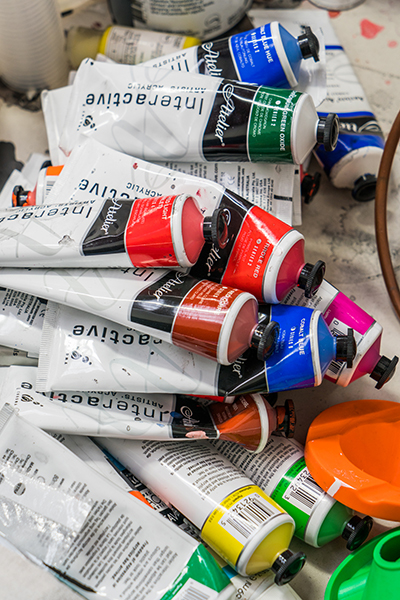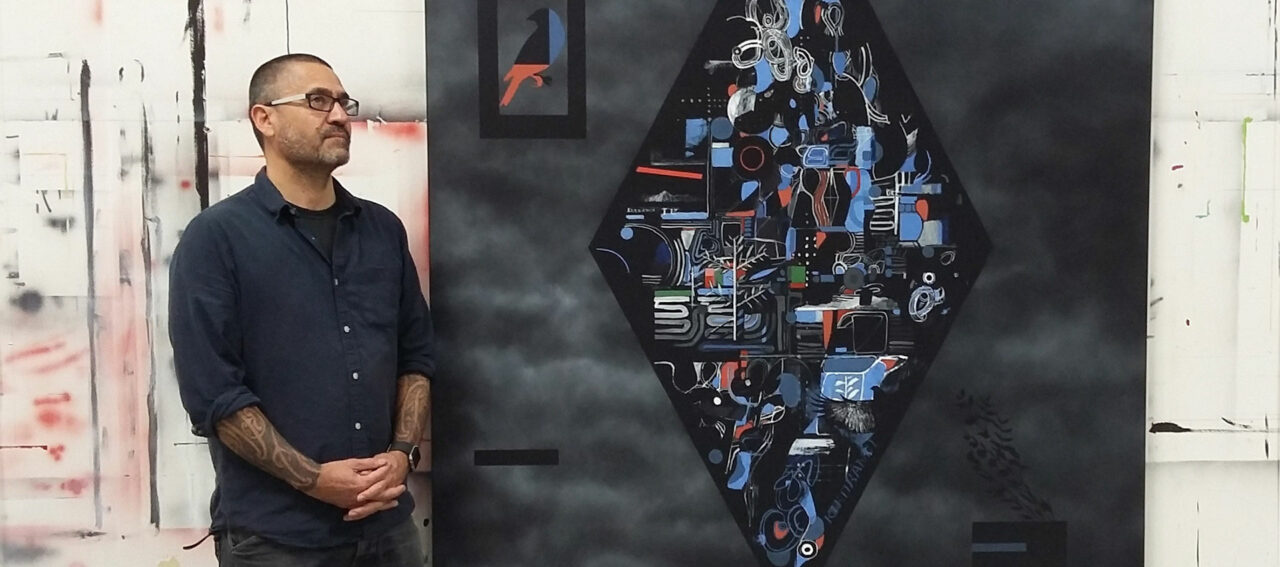 Shane, you’ve talked about your use of text in your works before. There’s quite a difference between the amount of text in the working drawing and the finished piece. Did you find that you just didn’t need it in the end?
Shane, you’ve talked about your use of text in your works before. There’s quite a difference between the amount of text in the working drawing and the finished piece. Did you find that you just didn’t need it in the end?
Well, the text there was just notation. Sometimes the notation becomes part of the concept, an integral part of the image, and in that case I employ the text like an image. But I felt that as the painting progressed, I didn’t actually need all those notations and those reminders, those triggers. I felt that the image itself was enough to carry it. And the working drawing, the schematic, they were really sort of and indicator for me, about things that I would maybe want to think about in terms of bringing into the image itself.
Does text take on a different role in your paintings than it does from the way, say, McCahon used it?
Yeah, I think it’s totally different. My use of text in an image really goes back to wanting to know about the importance of literature for Māori, and how that became a kind of new vehicle within which concepts and understandings about the new world were being conveyed. So text featured in a lot of meeting houses that were made at the turn of the century, and also new images, and the text and images ran alongside each other, which is really what my interest in painting is: how that initial thing came about, and then how I’ve chosen to employ some of that, as recognition of that place and time for Māori artists
And your use of the diamond motif, is that a reflection of that as well?
That’s from a similar era too. The diamond is a shape that features in a lot of tāniko and tukutuku patterns, it features in Māori carving. I became very interested in it when it featured in a narrative to do with Te Kooti, about how he was talking about the special nature of a stone placed under a maunga, and that’s where the essence of that place is. Sometimes he’d refer to it as a diamond shape. For me that’s been the stepping-off point in terms of the use of the diamond. The diamonds in the paintings for me are sort of like doorways. They split the sky open, and then those doorways are these moments of freedom, of clarity. I like the idea in a painting – or the one I’ve done for Te Manawa – where you have this cloudscape, which we can all relate to, and then you have this gap in the sky. And in this place I’ve just unleashed this freedom of painting.
It’s a recognition and it alludes to previous Māori artforms, and the narratives behind them, but it’s just something that I’ve taken on a journey myself; it’s become a shape or a motif I’ve used for many years, but now I’m really starting to make it the main character in the painting.
You’ve also revisited the dark clouds and the mountain skyline. Now I’ve heard the term “Māori gothic” coined; does this relate to that, could you tell me a bit about that?
I don’t really have a take on the idea of the gothic – although I did have a show called “Māori Gothic”, but that was different work. I think, in a way, the cloudscapes really do define this area so much – to the point that everyone who lives in Manawatū knows that if you travel through the Gorge, when you get to the other side quite often it’s clear. So the mountain range is like a demarcation, it’s a divide. Our side is, unfortunately, the cloudy side – that’s what I like about it. It defines the place. So when painting, it’s very good, because I can use the idea of the cloud as a device to create a very strong foreground and background. It’s as much a kind of device that allows me to make comment about this particular place, but it’s also a device in the painting that allows me to pull distance out of a painting. I think there’s a – I don’t want to use the word “doom” – but there’s a sense that…sometimes the paintings are so upbeat because of the heavy cloud. But I see them as being upbeat sometimes in terms of the treatment of the other images that were employed in the context of the work.
Part of your relationship with Manawatū.
Yeah, I think so. It’s really come out of that. And I came across the cloud thing when I was dealing with the idea of skyscapes, and I was trying to find a way to allow the images – the main characters in the painting – to come forward, and the best way to do it was actually make a background that was out of focus. So I just starting spraying it, and they just became clouds. So then that became the sky for me, it was that easy.
Are there any other elements of your relationship with Manawatū included in the painting?
Well I’m very interested in the term “Manawatū”. Just that word itself, “the standing heart” or “the heart that stops”. I was talking with a colleague, and he teaches up at Massey, and he conveyed a story to me about – well, ONE of the stories associated with how that name came about: it was when one of the first explorers or people to come to this place, they came into it from a high point. They looked down the valley and it was just so beautiful that it stopped his heart. You know that expression where something is just so incredibly sublime that you’re completely taken aback. That’s one of the stories; I just thought “well, wow, that’s it in a nutshell, really”. And so I’ve really just tried to look at aspects of the idea of manawa – which is “heart” – and tū – “stand” – or manawa ora, and pull some of the meanings out of those ideas to help generate what the picture could be. So the idea of the heart is really about the idea of the essence, it relates back to the diamond, the stone, the essence of a place, what it is that you bring to a place to actually draw the essence out and how that give you power. All those things for me, in terms of living in Manawatū, have allowed me to become the person I am in terms of my painting, which is what I’ve tried to convey – well, not “convey”, necessarily, precisely – but its reponse to that.
But the main thing that comes out of that also, when you you think of it, is the river, which is why I’ve put the word “river” at the top. I think that sometimes it’s a feature in our landscape that we take for granted, that we don’t always necessarily totally understand, or that we’re at one with. I remember when I was up at Māori studies, and I was doing a Māori language paper, and one of the first things the lecturer said to us on our first day, he says “when you go back across the bridge, just give a little mihi to the river. Just go ‘kia ora Manawatū’”. And ever since then – and I taught my kids to do it – it personifies the river. It makes the river real in the sense that it’s living, it gives it an aspect of humanity. It’s such a simple thing to do. My kids still do it today: every time we cross the river, “kia ora Manawatū”. It’s one of those little wee snippets where the language helps you understand the place. So the river at the top of the painting has become a significant subheading to the work.
 Now in works like ‘Star Eater’, they’re intensely detailed, and then you contrast it with something like ‘Begin’ which is quite spare. Where do you draw the line when it comes to determining how much detail to put into a work?
Now in works like ‘Star Eater’, they’re intensely detailed, and then you contrast it with something like ‘Begin’ which is quite spare. Where do you draw the line when it comes to determining how much detail to put into a work?
Well each painting is its own world, and they’re reiterations on broader themes, I suppose. But ‘Star Eater’ is a work that really is about pattern, and I really wanted to make a painting that was vast, so that when you stood in front of it your eye could not rest in any one place, so there’s an economy in terms of the pattern. But when you stood back, you could almost make out a facial feature, so the whole pattern and painting comes together to make one single object, and as you draw closer it breaks down into little wee incremental details. So that was really a painting about pattern and about the sum and the parts and about how it makes up the sum of some thing.
With a painting like Begin, that’s really just another conversation. I was interested in the dialogue and conversation around a story between a rock and a bird. So I wanted to make it where the rock is set in time, time immemorial, and the hummingbird is caught in a moment of time – the idea of time is a thing that we – y’know, the story is about this rock and this bird but caught in this moment. And I was trying to deal with some ideas in and around that, those characters.
So the level of detail is a tool that you can use.
Yeah, I think so. I tend to follow my nose in terms of my work. One day I might make a discovery for myself about how pattern can be employed in a painting, and I might do six paintings based on it. And the next week, or the next month or whatever, I’ll come in, and it’s not – I push it out of sight and I’m just going to paint this bird for a bit, put it in the context and not really worry too much about it. So my painting does vary quite a bit in terms of those things, but I like to think that there’s some kind of underlying theme that binds them together
There’s quite a lot going on within the diamond in this painting. Did you have things that you wanted to include, or did it all just kind of develop organically?
I had a few things. I had a few images that I painted in the early nineties, when I first arrived in Palmerston. One of them was the potplant image; couple of them were the bird images. But I didn’t really…now that I look at the drawing, in the drawing or the initial painting, the configuration of it, they were very clear. What I found was that in the diamond I really wanted to almost disguise it, so I wanted a really sort of abstract space that overlapped and crammed things in, rather than things that specifically stuck out. And the reason I wanted to do that was I kept thinking about the way a river flows. It’s always changing. Sometimes it’s gentle, and sometimes it’s full on, but it’s got momentum about it, and there’s a sense that everything’s being channelled, and I just really wanted the painting to reflect that. So while there are those things in there, they’re kind of disguised. The images are built up, they’re compacted. There are a few things that you’ll see that pop out, but for the most part I just wanted…I wanted it to have structure but I didn’t want it to be too mannered, in terms of the structures within the diamond.
Tell me about the forms outside the diamond. What’s their purpose?
The one on the right is a reference to the potplant form, although it’s a more updated version. It’s very hard edged, it’s windblown a bit, so it’s swinging in towards the diamond, that helps give a visual cue towards the diamond. The little wee framing device on the landscape…again it’s really about the idea of the way that one frames a work. Thinking about painting, the way painting can actually frame up an idea, it’s a self-reference to that, the importance of what happens within the space of the painting. The image sitting on the top left hand side is one of the early bird images I did. It’s based on the shape of a goldfinch, although it doesn’t look like a goldfinch there. It’s really just a reference to earlier work. So again, they’re very personal interpretations of things I’ve done [during] my time in Palmerston, really. The hard-edged shapes that you see occuring in the sky are structural things for me, things that help break up the sky and give some kind of compositional structure to the diamond. They’re compositional devices and not necessarily thematic, but they complement the diamond in a way.
In the past you’ve used provocative elements like the mokomokai, is there anything like that here?
No there isn’t. I thought about it but I just didn’t think that this particular work needed it. One of the ways I like to talk about the diamonds is the idea of the body – I talked about the river, how you personify it, so it has this human aspect to it. And I quite often think about the paintings as being the body somehow having a connection to the human, to us, what we are. But those are just ways of thinking about…sometimes you think about the the skin of the painting, so you reference the body that way – but nothing that relates directly to the image of the head in that work, no.
The really strong difference is the presence of the blue: River Diamond Blue. When I look at the work, when you were talking before about the river changing and shifting and intertwining, through and around, that’s a little bit what I see there. The kikorangi which is used there, is that a reference to the blue?
Yeah. Obviously I started off with the green. But I use blue a lot in my work, and it has those references, so there is a bit of green in that work but the blue overcomes, won the battle in the end, just something I decided to go with. Again, I don’t really see the river as being blue in that sky sense, it’s actually quite different. But when you think about the idea of river and you think about issues of water, I often think of blue. Blue is the colour of cleanliness and purity, somehow, and that’s why I’ve featured it in there. But I also think because of the previous works, again coming back to the notion of body, you know, kikorangi, “kiko” is flesh, “rangi” sky, those two things come together, they make that colour, that reference to the body again. Yeah.
And also just going back to this word, you know, Apiti, the separating between the two landscape forms started with Ruahine, and the diamond points straight to it, in the landscape at the bottom, and of course as it opens up it frees itself, this freedom notion that I was talking about in terms of expression of painting. I mean that’s the thing; quite often the names spark ideas, the names of places – well, it happens all the time with Māori placenames, that they spark ideas about whakapapa, and just really how you start to view that place, because of that name, it just sparks a whole lot of ideas, concepts.
River Diamond Blue can be seen in the Gallery building as part of the Supernova exhibition. Images by Udo von Mulert




